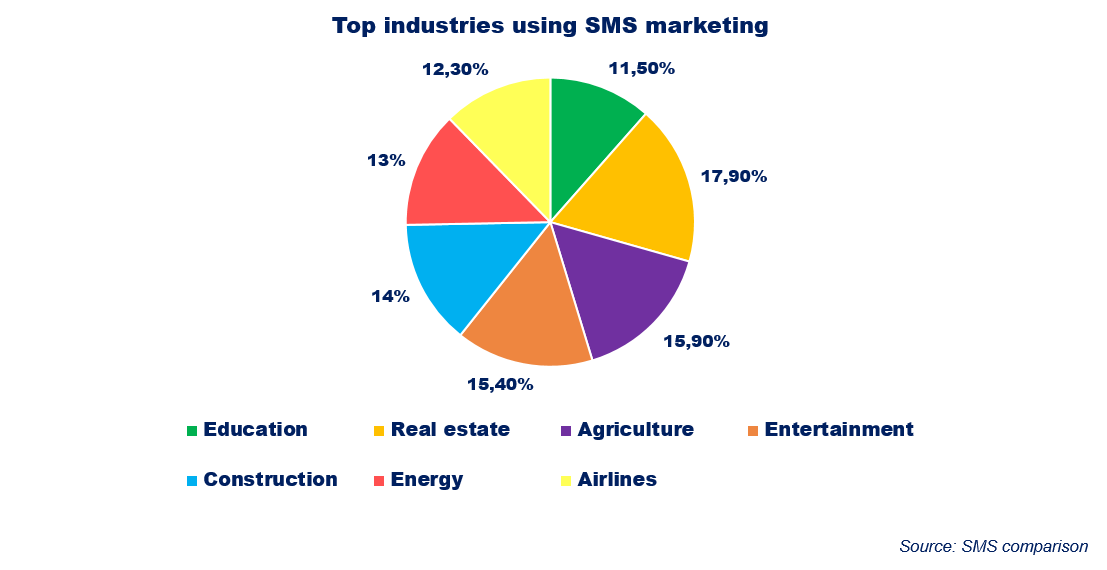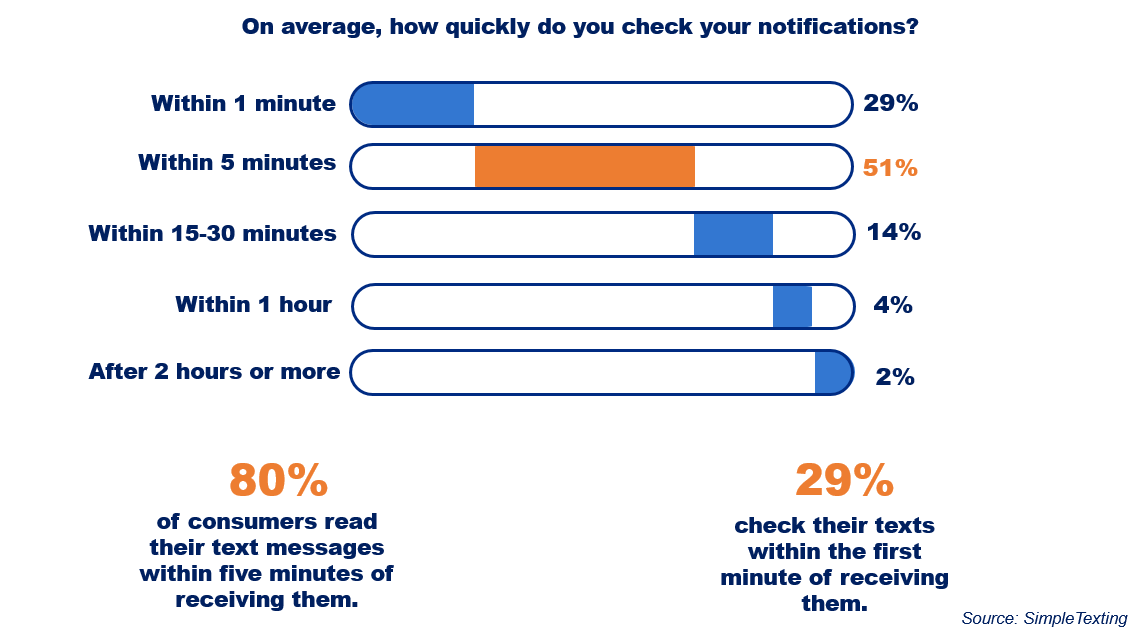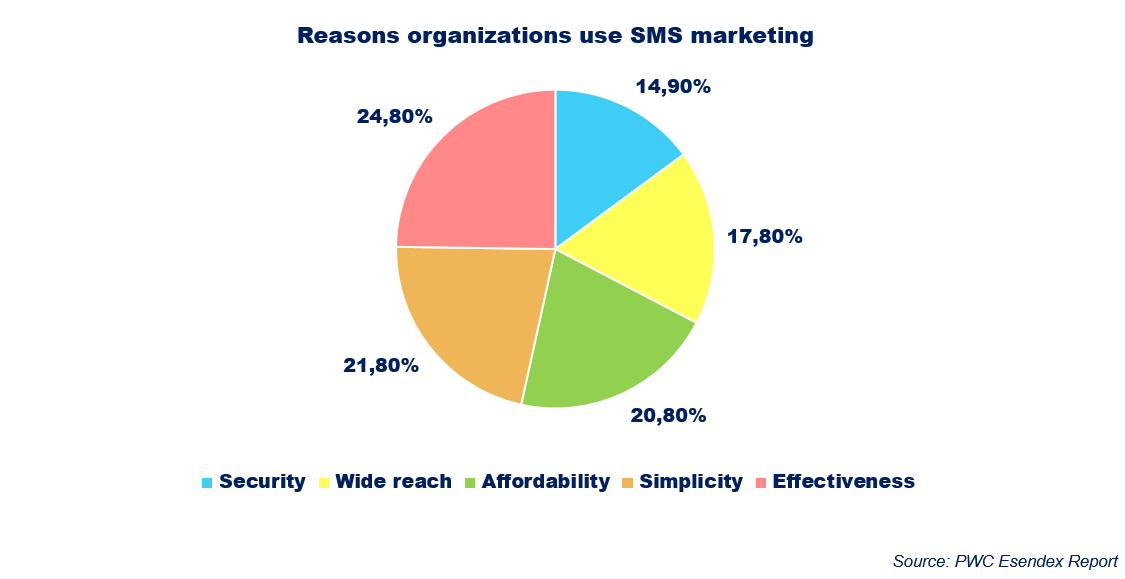SMS Marketing Statistics 2024 - The Ultimate List
SMS marketing stands as a leading strategy for businesses worldwide, effectively engaging customers and driving sales across diverse industries. It is proven to be one of the most successful marketing and communication methods, utilized globally for its demonstrable impact. If you are eager to get into recent statistics that highlight its effectiveness, you have come to the right place.
We have gathered a comprehensive set of research-backed SMS marketing statistics to address key questions such as:
- What is the size of the SMS marketing market?
- What is the success rate of SMS marketing campaigns?
- How does SMS marketing compare to other channels like E-mail marketing?
- What is the average open rate for text messages?
- And so on...
The main SMS marketing statistics in 2024
Market size
Worldwide, 327.1 billion dollars is spent on SMS marketing
- Global spending on SMS marketing currently stands at $327.1 billion, with the United States leading as the largest market. (Statista, 2023)
The United States represents 18% of global mobile capital expenditure
- Despite comprising only 4.5% of the global population, America contributes more than one-fifth of all mobile capital spending. Currently, industries such as hospitality, food service, transportation, and insurance in the United States have lower rates of capital investment compared to the wireless sector. (CTIA, 2021)
Worldwide, over 23 billion text messages are sent every day
- Worldwide, over 23 billion text messages are sent on a daily basis. Every second, about 270,000 text messages are sent, including those from brands reaching millions of consumers. Since 2020, SMS has become one of the most popular ways people communicate and is growing steadily in market size each year. (Forbes, 2024)
61% of marketers still do not use SMS marketing
- 61% of marketers have yet to adopt SMS marketing. Despite this, 73% of companies plan to boost their budgets for text message marketing in the near future. (SlickText, 2024)
Only 35% of brands have a formal SMS messaging strategy
- Only 35% of brands currently have a well-defined SMS messaging strategy. The majority, approximately 65%, admit to operating without a formal plan for SMS marketing. This presents a significant opportunity for businesses looking to explore SMS marketing, as those with structured strategies tend to achieve better outcomes compared to their competitors. (SlickText, 2024)
33% more people have access to mobile phones than restrooms
- Over 6 billion people have phone access, and an estimated 5 billion send and receive SMS messages daily. This means nearly 65% of the world’s population can send a text, compared to those using indoor plumbing. (Luisazhou, 2024)

SMS marketing success
The average open rate for text message marketing is 98%
- early every marketing text message sent is opened. Up to 45% of recipients respond to these SMS marketing messages, enabling businesses to engage customers in real-time dialogue. In comparison, E-mail marketing campaigns typically see an open rate of less than 20%. (Crazy Egg, 2022)

90% of consumers reply to texts within 30 minutes
- A survey shows that 9 out of 10 people respond quickly to texts. With a lead conversion rate of 15% compared to just 1% for sales calls, SMS is much more effective. (EZ Texting, 2024)
More than 50% of consumers buy items after receiving a promotional text
- Over 51% make purchases directly after getting an ad, discount voucher, or QR code from companies. Including images and other media in SMS marketing messages boosts conversion rates. Additionally, 33% of consumers don not mind receiving SMS promotions as long as the content is relevant to them. (Attentive Mobile, 2021)
73% of marketers say SMS boosts their revenue
- About one-third also find that SMS increases their average order value and overall customer lifetime value. (Attentive Mobile, 2023)
Text-based coupons are used 10 times more often than paper ones
- A study found that SMS vouchers have a high conversion rate, with 32% of recipients responding to offers. (Adobe, 2015)
SMS marketers generate $71 for every dollar spent
- Attentive Mobile, an SMS marketing company, reports that its retail and eCommerce clients see an average return of $71 per dollar invested in SMS marketing. These customers also achieve an average of 20.5% of their total online revenue from SMS campaigns. (Attentive Mobile, 2021)
SMS marketing growth
The SMS marketing sector is projected to reach a value of around $12.6 billion by 2025
- Experts forecast a compound annual growth rate (CAGR) of 20.3% for the US SMS marketing market from 2019 to 2025, driven in part by new AI-enabled solutions making SMS services more efficient and accessible across industries. (Grand View Research, 2022)
The media and entertainment sector is poised for significant growth with a projected CAGR of 22%
- While retail businesses lead in SMS marketing usage at 23%, the media and entertainment industry is expanding its use of SMS for promoting movies, TV shows, events, and more from 2019 to 2025. (Grand View Research, 2022)
Small and medium-sized enterprises (SMEs) are expected to experience a CAGR exceeding 23%
- While large businesses currently dominate SMS marketing, SMEs are rapidly adopting SMS strategies. For instance, Subway successfully utilized SMS marketing to reach over 5 million users by 2018. (Grand View Research, 2022)
33% of marketers plan to prioritize mobile loyalty programs
- About 33% of marketers expect to prioritize mobile loyalty schemes and coupons in their plans for next year. (SlickText, 2024)
SMS marketing market will grow to USD 38.44 billion by 2030
- Data Bridge Market Research predicts the SMS marketing market will grow to USD 38.44 billion by 2030, with an annual growth rate of 21.26% from 2023 to 2030. (Data Bridge Market Research, 2023)
A2P SMS messaging market will reach $89.2 billion by 2030
- A report by TextUs, using Beyond Market Insights, predicts the A2P SMS messaging market will reach $89.2 billion by 2030, growing at 4.1% per year from 2022. (TextUs, 2022)
Businesses using SMS marketing
47% of companies across various sizes and industries use mobile texting
- In a survey by PwC, nearly half of the respondents reported using mobile messaging. Specifically, 39% of small and medium-sized enterprises (SMEs) and 58% of large businesses employ SMS marketing strategies. (PWC Esendex Report, 2021)
46% of banking and finance organizations have increased their spending on SMS marketing
- Companies are increasing their investment in SMS marketing. Specifically, 42% in retail, 45% in IT/communications, 34% in professional/administrative services, and 36% in the industrial sector have also raised their SMS marketing budgets. (PWC Esendex Report, 2021)
25% of organizations use SMS marketing because of its effectiveness
- Companies choose SMS for various reasons: 22% for its simplicity, 21% for affordability, 18% for its wide reach, and 15% for its security. (PWC Esendex Report, 2021)
Coca-Cola allocates 70% of its mobile marketing budget to SMS services
- Large companies like Coca-Cola invest heavily in SMS marketing because they recognize the high frequency of smartphone interactions—over 2,617 times daily—and the preference of 85% of people for SMS in customer care. (SMS Global, 2022)

Consumer interest in SMS advertising
Globally, 63% of consumers engage with brands’ SMS programs at least twice a week
- 31% are engaging with brands’ E-mails, and 32% with branded apps, 2-5 times per week. (Attentive, 2023)
91% of consumers worldwide have either joined or are considering joining an SMS program
- They are not just receiving messages, they are actively engaging with brands throughout their customer journey, from discovery to loyalty. (Attentive, 2023)
64% of SMS subscribers are curious about new texts
- When receiving messages from businesses, 27% feel joyful, 23% are thrilled, 17% are anxious, and 17% and 15% are annoyed. (EZ Texting, 2024)
Most customers (58%) find texting to be the most effective way to reach them
- They appreciate receiving shipping/delivery updates (48%), discounts (29%), and appointment reminders (64%) as the most valuable types of text messages from businesses. (Business Wire, 2021)
SMS loyalty programs have benefited 90% of customers
- The majority, 90%, prefer receiving texts over phone calls or E-mails, with 75% also expressing interest in receiving exclusive offers via SMS. (SMS Comparison, 2024)
74% of consumers shop on their phones while watching TV at night
- These multitasking shoppers unwind by scrolling through social media and responding to texts. Often, they make purchases impulsively, clicking "buy" after seeing a post in their feed or a link in a group chat. (Attentive, 2023)
SMS vs E-mail marketing statistics
Less than 5% of SMS subscribers ever opt out of SMS marketing campaigns
- Only about 5 out of every 100 SMS marketing subscribers choose to opt out, whereas over 20% of E-mail users unsubscribe each year. SMS marketing shows much better retention rates than E-mail marketing (Text Request, 2023)
Sending a text message following an E-mail can increase open rates by 20% to 30%
- This approach not only enhances SMS marketing but also boosts the effectiveness of traditional E-mail campaigns, as demonstrated by a study where asking, "Have you read our E-mail?" led to higher engagement rates. (Adobe, 2015)
SMS texts typically achieve a response rate of 45%, far surpassing the 8% response rate for E-mails.
- This high engagement level demonstrates how SMS marketing encourages customers to actively interact with brands. For instance, Time Warner increased late bill collections by 49% using SMS techniques in debt collection efforts (The SMS Global, 2022)
SMS marketing lists are valued ten times more than E-mail marketing lists
- Marketers prioritize phone numbers and opt-in consent as ten times more valuable than E-mail addresses. For instance, having 100,000 SMS subscribers is considered equivalent to having 1,000,000 E-mail addresses in terms of marketing impact. (Mobile Marketing Watch, 2017)
Times when people are most likely to make a purchase via SMS
- Evening: 45%
- Afternoon: 25%
- Midday: 13%
- Morning: 9%
- Late night hours: 8% (Klaviyo, 2024)
Summary
These statistics show how important SMS services are for business growth and customer engagement. By looking at real cases and data, the article shows the strong impact of SMS marketing on different industries and business sizes. It proves that SMS marketing is a powerful way to reach customers quickly, leading to more sales and better customer loyalty. The data shows that businesses using SMS marketing have higher engagement rates than other marketing methods. Overall, the analysis clearly shows that SMS marketing is an essential part of today's business strategies, helping companies connect with their customers.
